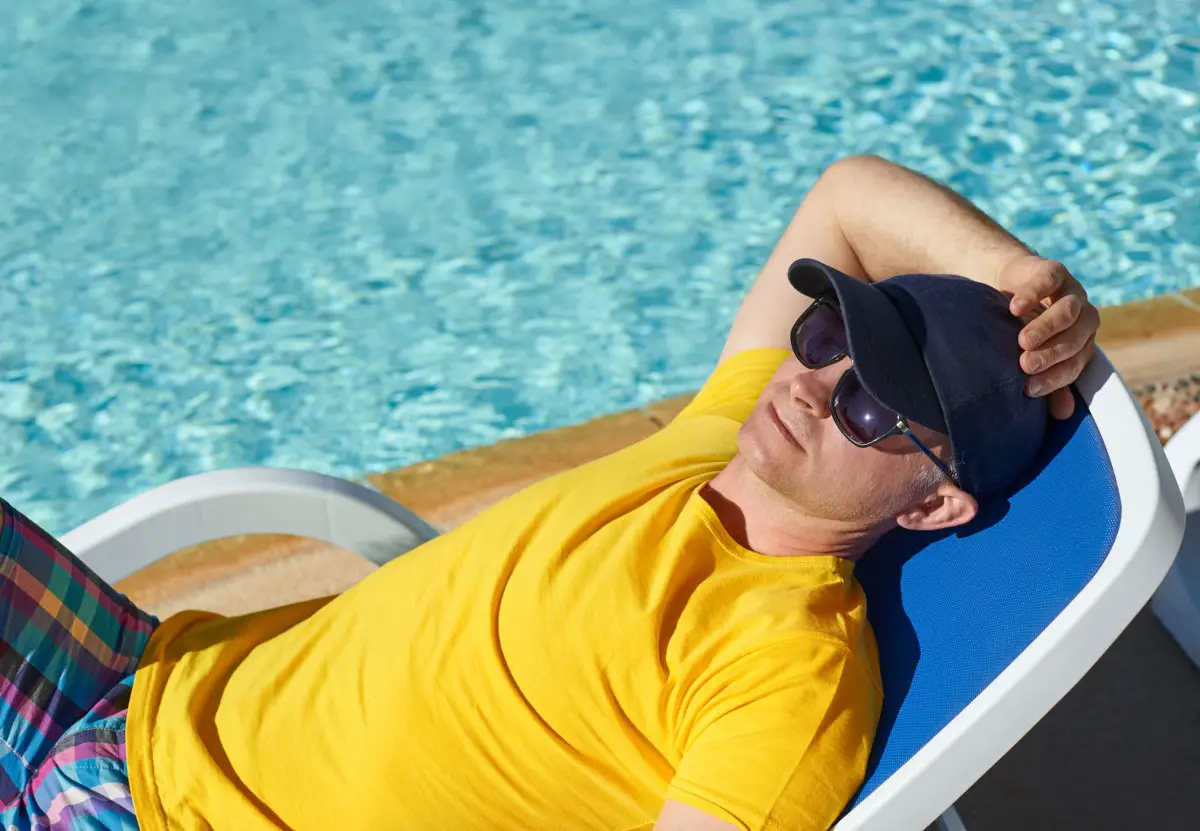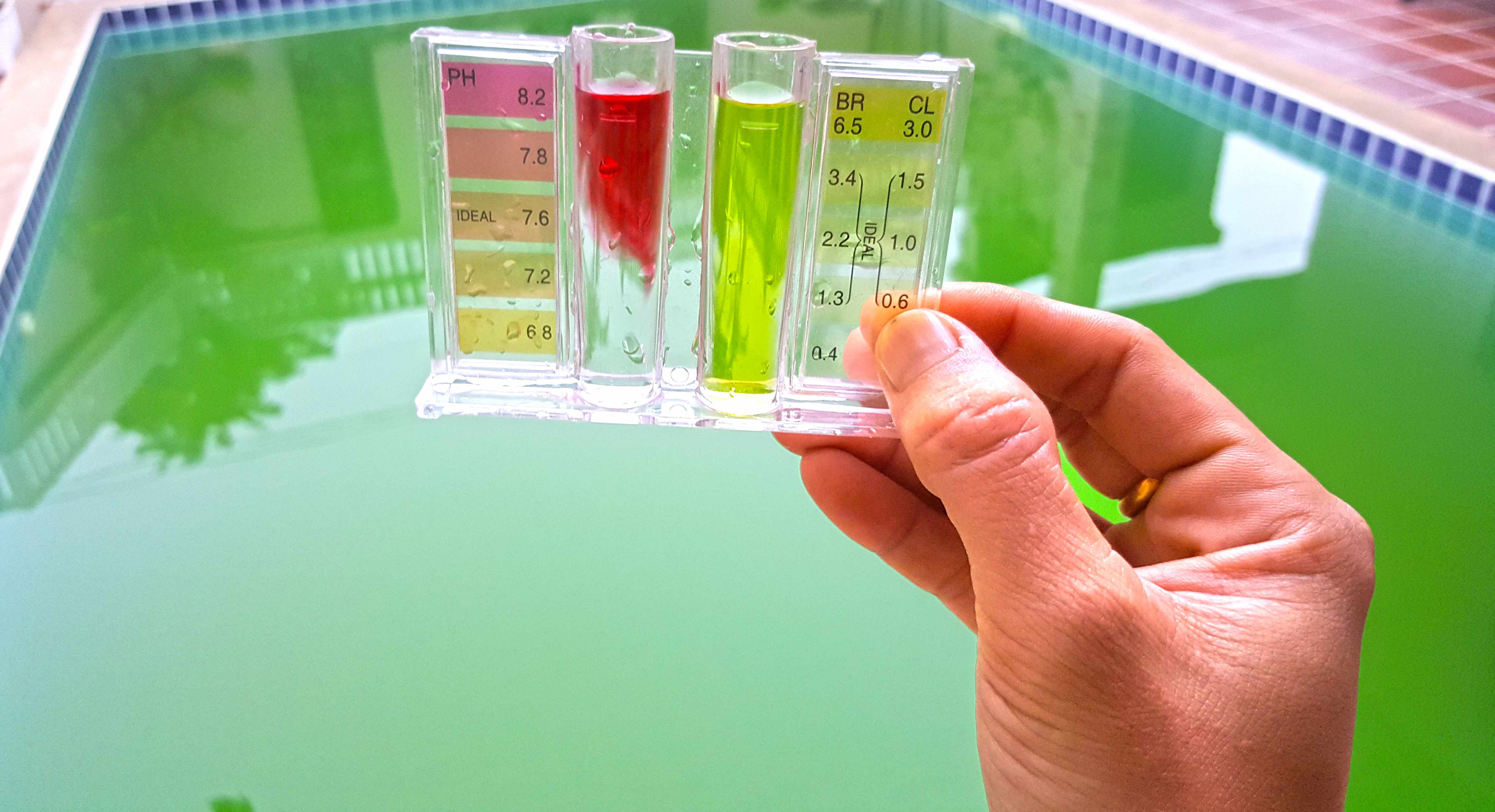Being a Pool owner has its ups and downs, especially with an Inground older Pool that is as big as mine. There is almost a Captain’s feeling you get when you have a boatload of kids and grownups who come over to dip their feet in, after all, you take pride in how good your Pool looks and even advise the newbies who just started with their backyard Pool. Then all of a sudden your pool water turns emerald green overnight. Why Did My Pool Turn Green Overnight?
Pools turn green because of these issues
Adjust in this order:
- Alkalinity adjust to 80-120 ppm
- pH Adjust to-7.4-7.6
- Super-chlorinate/Shock
- Pool will turn a whitish-green/Aqua color
- Use a Flocculent/Clarifier to settle the floc out
- Wait-then vacuum debris off the bottom to waste
- Filter 24hrs.
- Backwash as needed
Depending on how far you let it go will be how fast you gain control again Every once in a while even a Pro Pool Guy like yourself, Doesn’t shoot par, it happens to the best of us, you just need to know what to do-Fast!
Why Did My Pool Turn Green Overnight
The temperatures came up over the weekend into the ’90s and kids just couldn’t stay out of the pool. It was the kind of weekend that you wanted to lay around and listen to the ball game or some tunes. Even the dog was jumping in and out to stay cool. You did the normal jobs when it was time to go in and called it a day. Trace what you did before it happened:
- You added your chemicals
- Backwash your filter
- Added some Shock Chlorine because of the extra usage and warmer temperatures.
- The timer was set to run all night
Shut the lights down and go in. So what happened?
The next morning when you woke up you looked out at the pool and couldn’t believe what you saw your pool was green. Emerald Green from an Algae Bloom. This doesn’t happen very much. You take pretty good care and regular testing of your pool. Everyone owns any kind of Pool.
Whether it’s inground or above ground experience the pain when your neighbors yell from the next yard and say “Hey Bud your Pool’s green”
You know how to take care of your pool because you have been doing right for years. Longer than any of your neighbors have. It must have been a rainstorm that rolled in and out last night that poured Acid rain or chemicals. Maybe it was the neighbor’s kid who carried something in his pocket when he jumped in the water and sabotaged my pool. Most likely not!
My Pool Has Light Green Colored Algae Pool Water
Your pool water is somewhere in between aqua and light green like it’s on its way to Emerald Green but something is holding it back you know in your Pool Captain’s heart that it won’t get better. This thing is only going to get worse.
You check the Chlorine residual and see plenty of Chlorine in the pool. Even though the pool water is turning green there is a good amount of yellow residual from the test kit staring at you. So what else do you see? What else do you smell? What do you hear? Never mind that the guy from next door yelling across the yard telling you “Your pool’s green”
The Pool water looks green but clear. The green color is involved with the Pool water. It is not patches that can come from algae growing in the concrete in sunspots on the Pool floor or walls. Sometimes green spots can grow in patches that were exposed to the sun the day before.
Algae hide to protect themselves. Underneath dead Algae or in cracks and crevices that Cement or Concrete can provide. The pool water is fine and needs to be scrubbed down and filtered longer or most likely it’s just the Pool’s Chemistry. It slipped and wasn’t strong enough to hold the Alkalinity-then pH-then the Chlorine Residual.
Pool Water Looks Green but is Clear
Can You Swim In A Green Pool With Algae
How to Treat a Pool With Green Algae Fast
The fast way to move in for the kill is first to get the Pool water sanitized and give it a swift kick of Chlorine Residual. You could drop a ton of Shock Chlorine and it won’t work. You are just putting the horse before the cart. There is an Algae bloom in your swimming pool and there is no time to waste.
The sun will straight up in the sky right over the pool and the temperature will heat it to make a soup full of microbes turning your light green colored Pool greener than Ireland, laddy!
First:
- Don’t Panic-Get On It Fast
- Check Alkalinity it’s most likely too low or high – this happened the last week or so and you didn’t notice!
- Adjust it to 80-120 ppm this will take a few hours
- Adjust pH-7.4 is perfect
- Shock the pool-This is called Superchlorination-Go ahead Don’t be afraid
- Use a Clarifier or Water Polisher to settle out the colored Algae-The Pool will turn a lighter green or an Aqua colored-then Blue
- Wait Then Vacuum
- Backwash
- Filter
- Depending on how far you let it go, the faster you will gain control again
Yes, there could have been a mechanical problem you were backwashing and left the Multi-port’s handle un-seated and it pumped yucky stuff back in your pool Yup! That could have happened or the Jolly Green Giant cut through your yard and took a pee in your swimming Pool but 90% of the time your pool water goes greenish overnight for no reason it has to do with pH slipping because the Alkalinity buffer was not strong enough. You’ll be able to see all this with the results from Testing Pool Water.
Remember it’s easy! The Alkalinity Bone is connected to the pH Bone & the pH Bone is connected to the Chlorine Residual Bone. The Chlorine Residual Bone keeps your Pool blue and your neighbor from yelling across the yard reminding you why you want to move away so much!
Conclusion:
In conclusion, if your pool water appears green but remains clear, it is likely due to metal contamination or a chemical imbalance rather than algae. By testing the water, adjusting chemical levels, and using a metal sequestrant, you can address the discoloration and restore your pool to its pristine condition. Regular maintenance and preventive measures are essential to ensure your pool water stays clear and inviting, providing a safe and enjoyable swimming environment.
For more great information on testing pool water for the upcoming season stay here at MyWaterEarth&Sky-A pool owner needs reliable testing and sampling procedure using reagents, test strips, or digital probes to perform basic maintenance tests for pH, alkalinity, calcium hardness, and of course chlorine ………………………….. Continue reading
References:
Arm & Hammer-What Causes Green Pool Water & How to Fix It
FAQ’s
1. Why is my pool water green but clear?
- Answer: Clear green pool water is usually caused by the presence of metals, such as copper or iron, which can oxidize and give the water a green tint. It can also be due to chemical imbalances, particularly high pH or alkalinity levels.
2. Is it safe to swim in a green but clear pool?
- Answer: While the water might appear clear, it’s important to test for and address any chemical imbalances or metal contamination. Swimming in such water can still pose health risks if the water chemistry is not properly balanced.
3. How can I test for metals in my pool water?
- Answer: You can use a pool testing kit that includes tests for metals like copper and iron. These kits are available at most pool supply stores and can help identify the cause of the green tint.
4. What should I do if I find metals in my pool water?
- Answer: If metals are detected, add a metal sequestrant to the water. This chemical binds to metals, preventing them from oxidizing and causing discoloration. Follow the product instructions for the correct dosage.
5. How do I balance the pH and alkalinity in my pool?
- Answer: To adjust the pH, use a pH increaser or decreaser based on the current levels. For alkalinity, use an alkalinity increaser. It’s important to test the water regularly and make adjustments as needed to maintain the recommended levels (pH: 7.2-7.8, Total Alkalinity: 80-120 ppm).
6. Will shocking the pool help clear the green tint?
- Answer: Shocking the pool can help if the green tint is due to organic contaminants. Ensure to follow the guidelines for shocking the pool based on its size and current chlorine levels.
7. How long should I run the pool filter to clear the water?
- Answer: Run your pool filter continuously until the water clears. Proper filtration helps remove contaminants and metals from the water, speeding up the clearing process.
8. How can I prevent my pool water from turning green in the future?
- Answer: Regularly test and balance the pool water, use a pre-filter when filling the pool if your source water contains high levels of metals, and be cautious with chemicals that may introduce metals into the water. Regular maintenance is key to preventing discoloration.
9. What is a metal sequestrant, and how does it work?
- Answer: A metal sequestrant is a chemical that binds to metals in the water, preventing them from oxidizing and causing discoloration. It helps keep the metals in solution, making them easier to filter out.
10. Can high chlorine levels cause green water?
- Answer: High chlorine levels themselves typically do not cause green water, but they can oxidize metals like copper, leading to a green tint. Maintaining balanced chemical levels is crucial for clear water.



